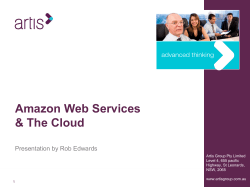
A Platform in the Cloud
Pharma Technology Focus Issue 31 October 2014 A Platform in the Cloud As clinical trials grow in scope and size, life science organisations are following in the footsteps of other industries in using cloud computing to automate and simplify complex research processes. John Anstey, enterprise systems architect at Medidata Solutions, discusses how the life science sector can successfully exploit the cloud A s the volume of clinical data required for regulatory submissions expands, every life science software vendor needs to develop systems that are scalable, flexible and robust. High performance is a given, a necessity. The sheer range of devices that now quickly produce vast amounts of source clinical data is staggering, including everything from smart phones to clothing, patches and bracelets. Add those to the pre-existing clinic-based diagnostic sources, and we face a virtual data tsunami. In the past, many software providers built individual, stand-alone products, each processing data separately from specific areas, such as labs, case reports, CT admin, drug randomisation and so on. However, if our industry is to succeed in the new ‘Internet of Things’ and harness this vast nascent data panacea, a more holistic solution is required – a platform in the cloud perhaps? O1 SHARED EXPERIENCE Currently, many software-as-a-service solutions consist of domain-specific products, which have been formed heterogeneously over a number of years. Some tools are purchased and others built in-house using the most suitable technologies at the time. many companies, including Audi, Seat and Skoda, each producing cars of all shapes, but what do they have in common? They are based on the VW Golf’s MQB platform. It is a ‘matrix’ of components which introduces rationality across the range. This would present any organisation with a dilemma. How can a software-as-a-service provider get diverse products to behave as a single logical unit to successfully handle the oncoming tidal wave of complex data without tearing everything down and starting again? Take a look at how a company, in a completely different industry, solved a similar problem of cost, effectively supplying many hugely varying complicated products quickly, reliably and with massive volumes. Volkswagen is one of the biggest automobile manufacturers and owns O2 Using this shared modular platform for transverse engine, front wheel drive cars, VW can produce a wide variety of vehicles that sell quickly and reliably on a scale that satisfies its market but does not lead to waste via over-production in anticipation of demand. Drawing a comparison, how can we develop a software platform that delivers the same benefits? We can’t create one from scratch as that would be too expensive. But neither did VW. Their route to a platform was evolutionary, with gradual shared component adoption over time. A NEW APPROACH Medidata is adopting this approach using service orientated architecture (SOA). At Medidata, we want all of our products to behave in concert with one another, as a platform, but to still retain each product’s unique value-add characteristics and intrinsic technology stack, for example Java, .Net, Ruby and so on. This can be achieved by adding services into the existing product mix so they can handle the activities that individual products share, such as authentication, feature authorisation, workflow management, alerts and notifications. O3 By separating out the common product functionality and delegating it into services, we’ve reduced complexity, standardised interchange-ability and increased product utility. However, developing services, or standard components, to take on the tasks already handled by innate product functionality only gets you so far. What you need to do next is add a new dimension so that the whole is greater than the sum of its parts. Each new service has to out-perform its original in-product role. This is achieved by the adoption of new cloud methodologies. INTO THE CLOUD The first of these new cloud methodologies is that each service has to be compliant with the twelve-factor methodology for building software-as-a-service apps and involves scalability. A service should be built so each constituent process can be duplicated across to another cloud server to take on more work should the load increase. This allows the application to ‘scale horizontally’ and increase performance to match the level of processing required by the users. It is one thing to spawn another process to carry an ever increasing user load, but it’s quite another to control it. The second approach concerns ‘auto-scaling’, which allows a client’s service to automatically scale up when certain pre-defined conditions are met, and to scale down and stop paying for the extra nodes when the user load drops off. The third involves making services more reliable by improving the way they are built, tested and produced by having each one as self-contained as possible. That way, when a bug does arise, it can be easily traced and rectified. The fourth approach concerns the adoption of hypermedia. We want our application programming interfaces (APIs) to behave like web-pages, where a developer can navigate to, and visualise, data more easily. This should allow them to write better quality integrations. The fifth and final method concerns a unified reporting strategy. Using SOA, we can combine the audit trails from all of our component modules and create a stateless, homogenised service-driven data feed that we can use for comprehensive, platformwide reporting and analytics. In short, to meet the ever-increasing demands for data from regulatory authorities, software-as-a-service providers have to make relatively diverse products work more closely together. Adopting a common component approach, as VW has done, gives us a flexible platform that is reliable and robust. And using a cloud-based service orientated architecture allows us to scale up and down, helping customers to run complex clinical trials cost-effectively. • MORE Pharma Technology Focus iPad magazine: bit.ly/PTFapp Web version: bit.ly/PTFmag info@mdsol.com | mdsol.com | +1 866 515 6044
© Copyright 2025





















